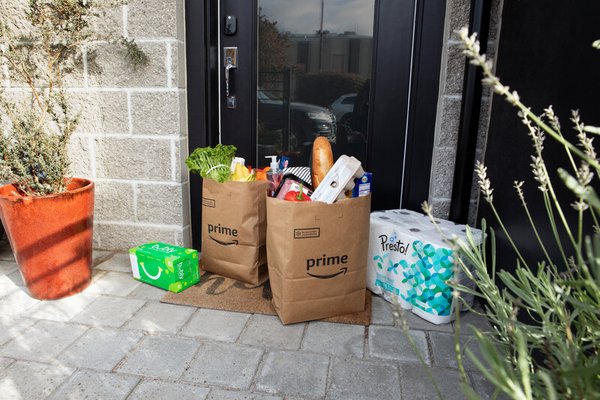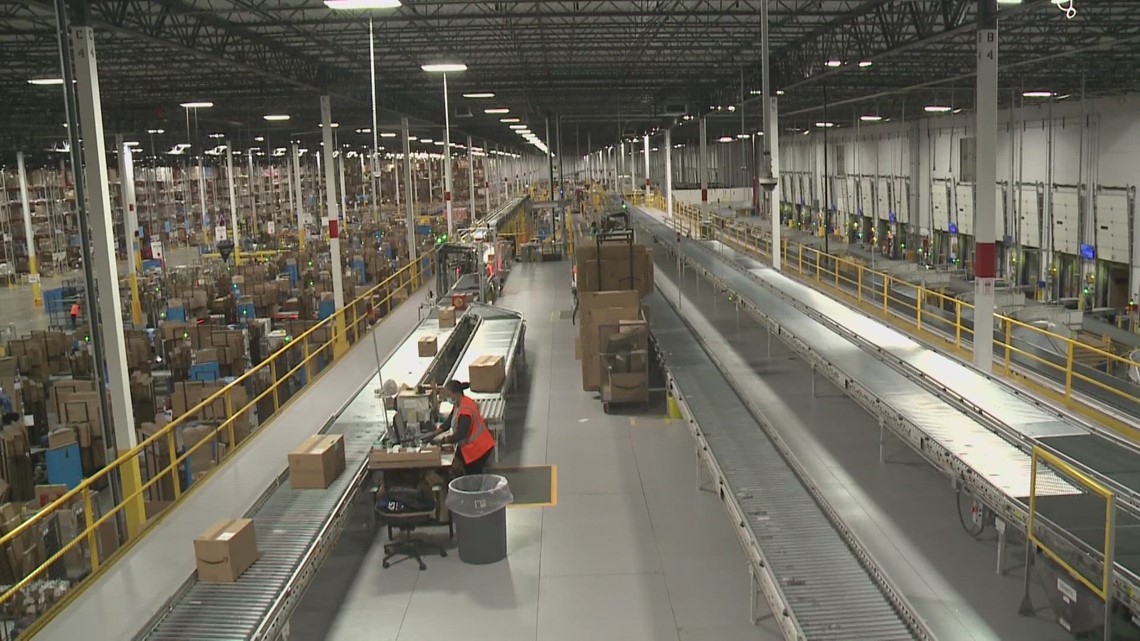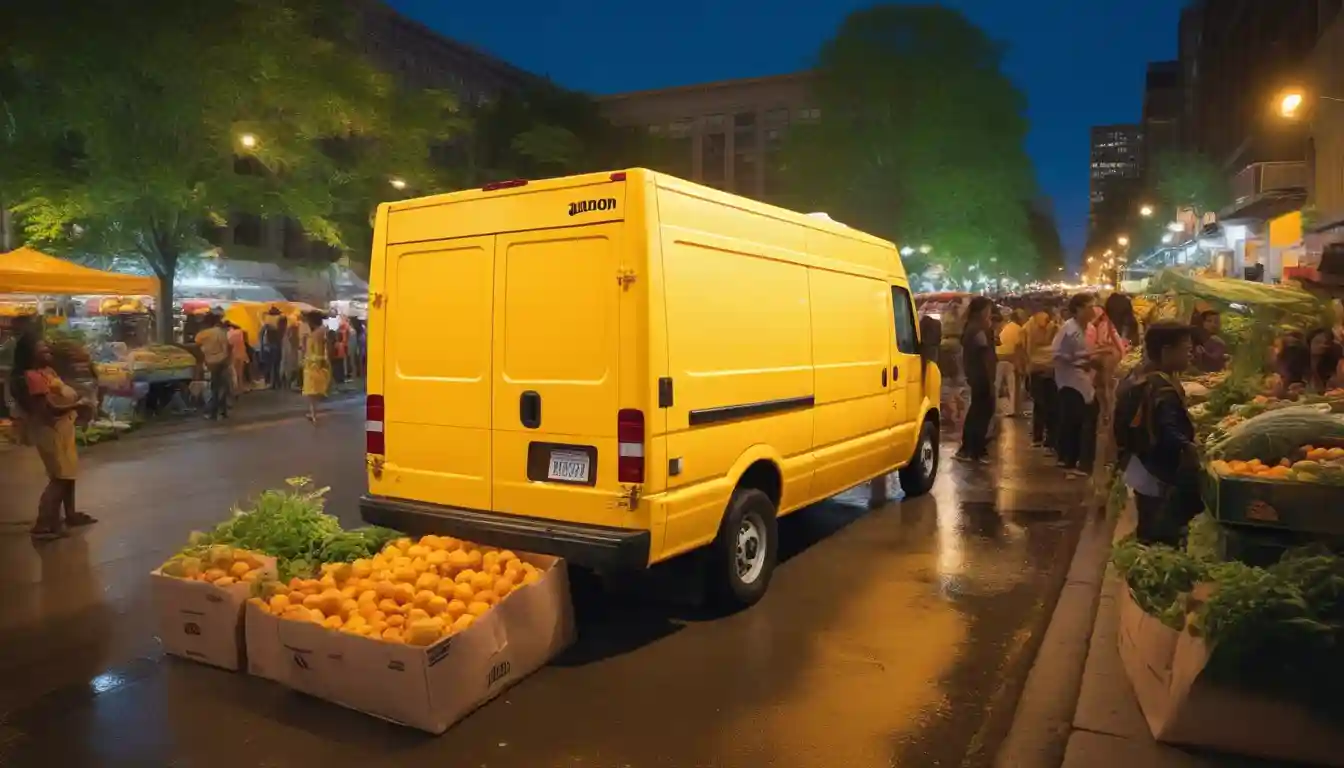Amazon's Grocery Gambit: The Silent Revolution in America's Pantry
PHOENIX, Arizona — The transformation began quietly, without fanfare or announcement. In test markets across Phoenix, Orlando, and Kansas City, something fundamental shifted in American consumer behavior—the temporal distance between craving and satisfaction collapsed into mere hours.

Amazon's expansion of perishable grocery delivery to over 1,000 cities represents more than logistical advancement; it signals the acceleration of what economists term "demand compression"—the systematic elimination of time between consumer impulse and fulfillment. This week's announcement, scaling to 2,300 cities by year's end, positions the e-commerce giant at the epicenter of a $180 billion grocery market increasingly defined by immediacy.
Demand compression is an economic phenomenon where demand that would typically be spread out over time becomes concentrated into a very short period. This rapid surge in purchasing activity places significant strain on supply chains, which must adapt to fulfill a high volume of orders in a condensed window.
The implications cascade far beyond convenience. With over $100 billion in grocery and household essential sales in 2024, Amazon has quietly become the pantry steward for 150 million Americans, wielding unprecedented influence over consumption patterns that reshape everything from agricultural supply chains to urban planning.
The Architecture of Instant Gratification
Amazon's seamless delivery promise conceals sophisticated infrastructure that reveals the true scope of this transformation. The company's "specialized temperature-controlled fulfillment network" represents a systematic reimagining of retail logistics, built on what industry analysts describe as the most significant grocery expansion in the company's history.

This infrastructure operates through a six-point quality control system, where each perishable item undergoes dual inspection—upon arrival and before dispatch. Temperature-sensitive products travel in recyclable insulated bags, identical to those used by Amazon Fresh and Whole Foods. Yet the innovation transcends cold-chain logistics; it lies in the psychological rewiring of consumer expectations.
The data illuminates this shift: strawberries, Honeycrisp apples, limes, and avocados now rank among the top 10 items in Same-Day Delivery carts. Fresh produce has transformed from planned purchase to impulse acquisition, fundamentally altering the relationship between intention and consumption.
"We're witnessing the dissolution of traditional shopping rhythms," observed behavioral economist Dr. Elena Vasquez at the University of Chicago's Booth School of Business. "When perishables become impulse purchases, we're seeing the emergence of entirely new consumption patterns."
The Competitive Battlefield Expands
Amazon's grocery expansion occurs within a fiercely contested landscape where traditional boundaries between physical and digital retail continue to blur. Walmart, leveraging its 4,700 U.S. stores as micro-fulfillment centers, has delivered 5 billion same-day items in the past year while reducing per-order costs by 20% through optimized logistics networks.
Did you know that as of 2025, Walmart dominates the U.S. online grocery delivery market with roughly 32–37% share, followed by Amazon at about 22% and Instacart at around 21.6%? Together, these three giants control nearly 70% of the market, leaving smaller shares to players like Kroger, Target, and Albertsons. With total online grocery sales projected to surpass $300 billion in 2025, the industry is seeing rapid growth fueled by increased delivery demand, more frequent orders, and innovations like express and even drone deliveries.
This physical-digital hybrid approach creates what market strategists term "delivery density wars"—a race to achieve sufficient order volume per geographic area to make same-day delivery economically sustainable. The competitive dynamics have created natural consolidation pressure, with smaller players struggling to match the infrastructure requirements of temperature-controlled rapid delivery.
Did you know that “Delivery Density Wars” describe the fierce competition among online grocery delivery companies to dominate densely populated urban areas where high order concentration makes deliveries faster, cheaper, and more profitable? By securing these high-density zones, companies can maximize delivery efficiency, lower costs, and strengthen customer loyalty, often by building networks of micro-hubs for ultrafast service. Winning in these areas can be the key to achieving profitability in the increasingly competitive grocery delivery market.
Market reactions reflect these strategic stakes. Following Amazon's announcement, shares of Instacart, Kroger, and Target declined, while Amazon gained approximately 1%—investor recognition of grocery market share's strategic importance.
"The quick-commerce space is experiencing infrastructure-driven consolidation that will fundamentally reshape the competitive landscape," noted retail analyst Michael Torres. "The capital requirements for temperature-controlled same-day delivery create inherent barriers to entry."
Rural America's Digital Transformation
Perhaps the most consequential dimension of Amazon's expansion lies in its planned $4 billion investment to penetrate 4,000 rural communities—markets representing approximately $1 trillion in annual personal consumption that have historically been underserved by quick-commerce platforms.

This rural expansion reveals strategic calculations extending far beyond immediate profitability. By establishing logistics infrastructure in smaller communities, Amazon challenges Walmart's traditional dominance in regions where physical retail presence has historically determined market leadership.
However, the economics of rural quick-commerce remain fundamentally different. Lower population density complicates delivery efficiency, while rural consumer purchasing patterns traditionally favor bulk buying—potentially conflicting with the impulse-driven model powering urban quick-commerce success.
"Rural markets may require entirely different economic frameworks," suggested supply chain expert Dr. Jennifer Walsh. "The unit economics that function in dense metropolitan areas don't automatically translate to dispersed rural geographies."
The rural expansion also raises questions about digital equity and infrastructure investment. As quick-commerce becomes increasingly central to consumer access, communities without robust delivery networks risk further marginalization.
The Psychology of Seamless Integration
Amazon's integration of perishable and non-perishable items into unified delivery represents sophisticated understanding of consumer psychology. The platform's ability to fulfill orders combining "milk alongside electronics; oranges, apples, and potatoes with a mystery novel" creates what behavioral economists term "category contamination"—the erosion of boundaries between different types of consumption decisions.
Category contamination is a psychological phenomenon where consumers perceive a product as less desirable or "contaminated" after it comes into contact with an item from an inappropriate category. For example, a food item might be devalued if it is placed next to a non-food product like cleaning supplies, even if there is no actual transfer of properties between them.
This integration carries profound implications for household budgeting and financial planning. When grocery items transform into impulse purchases bundled with discretionary goods, traditional expense categories begin to dissolve. The psychological distinction between "essential" and "optional" spending weakens, potentially altering fundamental patterns of American consumer behavior.
The pricing structure reinforces these psychological effects. Prime members receive complimentary delivery on orders exceeding $25, with a minimal $2.99 fee below that threshold. Non-Prime customers pay $12.99 regardless of order size—a model designed to drive membership adoption while making rapid commerce appear economically rational.
Market Dynamics and Investment Implications
From an investment perspective, Amazon's grocery expansion signals several transformative trends reshaping retail infrastructure. The convergence of e-commerce and perishable goods delivery necessitates substantial capital investment in cold-chain logistics, creating opportunities for companies specializing in temperature-controlled transportation and packaging systems.
Table: Projected Growth of the Global Cold Chain Logistics Market (Multiple Sources)
| Source / Forecast Range | Base Year Market Size (USD Billion) | Forecast Year | Projected Market Size (USD Billion) | CAGR (%) | Key Growth Drivers |
|---|---|---|---|---|---|
| Forecast 1 | 385.6 (2024) | 2034 | 1,359.78 | 13.46 (2025–2034) | Pharma, food sector demand, temperature-sensitive goods |
| Forecast 2 | 393.2 (2025) | 2035 | 1,632.6 | 15.3 | Biopharma, frozen food, last-mile delivery |
| Forecast 3 | 397.1 (2024) | 2032 | 1,096.6 | 16.0 (2024–2032) | Pharma, fresh/frozen food, IoT, AI, compliance |
| Other Estimates | — | 2032–2033 | Trillion-dollar scale | 12.3–13.0 | Healthcare needs, perishable food demand, tech innovation, regulatory requirements |
Competitive pressure on traditional grocery retailers may accelerate sector consolidation, as smaller chains struggle to match integrated digital platforms' convenience and pricing. Regional grocers with strong local market knowledge could benefit through strategic partnerships with major delivery platforms.
Supply chain companies focused on last-mile delivery optimization may experience increased demand as retailers seek cost efficiency. The emphasis on specialized fulfillment networks suggests potential value creation for logistics real estate investment trusts specializing in distribution facilities with advanced environmental controls.
However, investors should carefully consider margin pressure inherent in quick-commerce models. The substantial costs of maintaining delivery speed and quality standards may limit near-term profitability, particularly during expansion into less dense markets where achieving operational efficiency proves challenging.
The broader implications extend to agricultural supply chains, which must adapt to more frequent, smaller-volume orders. Food packaging companies may benefit from increased demand for temperature-stable, delivery-optimized products. Urban planning and commercial real estate face potential disruption as consumer traffic patterns shift away from traditional retail locations.
The Reshaping of American Commerce
Amazon's grocery expansion embodies more than operational advancement—it represents a philosophical transformation toward frictionless consumption that may fundamentally alter American shopping behavior. The company has constructed infrastructure making immediate gratification appear economically rational while obscuring convenience's true systemic costs.
As this model extends to 2,300 cities and beyond, the implications cascade through multiple economic sectors. Traditional grocery retailers confront existential pressure to match delivery speeds and selection breadth. Urban planners must reconsider commercial real estate's role as consumer behavior shifts from physical to digital platforms. Agricultural suppliers face pressure to adapt production and distribution models accommodating rapid fulfillment cycles.
The ultimate question remains whether this transformation enhances genuine consumer welfare or merely accelerates consumption patterns that may prove economically and environmentally unsustainable. As Amazon reshapes America's pantry infrastructure, the true cost of convenience represents an ongoing calculation—one that will determine whether this grocery expansion signifies genuine progress or simply the systematic monetization of consumer impatience.
The broader transformation suggests we stand at an inflection point where traditional retail categories dissolve into integrated digital experiences. Whether this evolution serves consumer interests or merely concentrates market power remains an open question with profound implications for American economic structure.
Investment analysis suggests monitoring quarterly earnings from major grocery retailers and logistics infrastructure companies for indicators of market share evolution. Historical performance does not guarantee future results, and readers should consult qualified financial advisors for personalized investment guidance.
